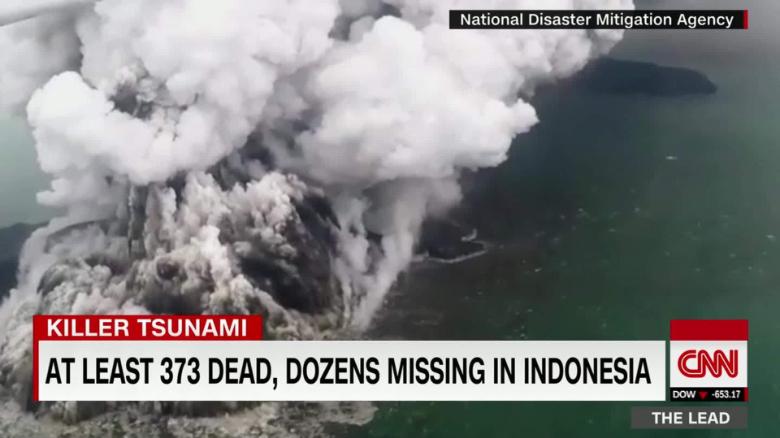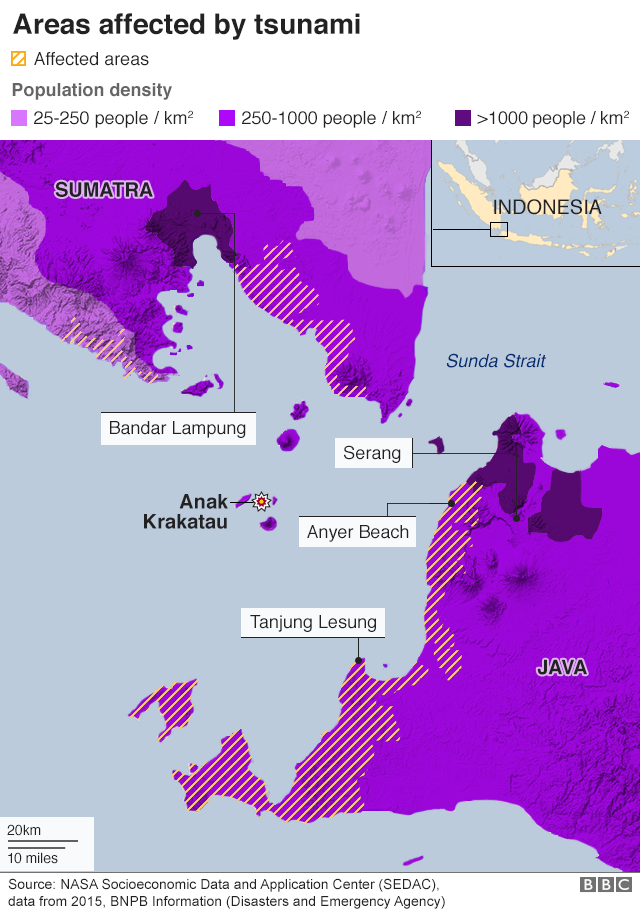Volcanic Eruption, Tsunami, No Prior Notice, No Escape
"Suddenly, a one-metre [3.3-foot] wave hit me. I was thrown into the fence of a building about 30 metres from the beach and held onto the fence as strong as I could, trying to resist the water, which felt like it would drag me back into the sea."
"I cried in fear... 'This is a tsunami?' I was afraid I would die."
Azki Kurniawan, 15, vocational training student
"The tide rose to the surface and dragged all the people on site."
"Unfortunately, when the current receded, our members were unable to save themselves while some did not find a place to hold on."
Indonesian pop band Seventeen, statement
"Actually, the tsunami was not really big, only one metre.":
"The problem is people always tend to build everything close to the shoreline."
Gegar Prasetya, co-founder, Tsunami Research Centre Indonesia

Indonesia represents a vast archipelago of over 17,000 islands, and has a population of over 260 million people who live along the "Ring of Fire", an arc of volcanoes and fault lines situated in the Pacific Basin. Saturday's tsunami was caused, in all likelihood, by a flank of the volcano collapsing; a large area of the volcano's slope giving way triggering a landslide or beneath the ocean, a disruption powerful enough to be capable of producing gigantic sea waves.
In 2004, a massive magnitude 9.1 earthquake hit Indonesia, spawning a horrendous tsunami off Sumatra Island which killed over 230,000 people in a dozen countries, most of them in Indonesia. Anak Krakatau volcano is considered to be the successor of the historical Krakatoa volcano that erupted massively in 1883, known to be the most devastating such event in recorded history, an event where over 30,000 people lost their lives when tsunamis ensued and so much ash crowded the sky that a drop in global temperature was recorded.
The explosion destroyed the huge volcano, sinking much of the island in the Sunda Strait between Java and Sumatra between the Indian Ocean and the Java Sea until around 1920 when Anak Krakatau began rising from the site, growing each year, and periodically erupting, considerably smaller though it is than the original Krakatoa.
Although scientists, along with some from Indonesia's Meteorology and Geophysics agency, felt the tsunami could have been caused by landslides below water; alternately above ground, on the steep slope of the Anak Krakatau volcano, tidal waves caused by the presence of a full moon were also cited as potential causes. Nine hotels and hundreds of homes were damaged or leveled by the waves in the city of Bandar Lampung on Sumatra.
At last count, 375 people lost their lives, 1,459 were injured and another 128 people are missing. All together, to date, 5,600 people have been displaced by the disaster. An astonishing 558 hotels were completely destroyed throughout the range of the tsunami's effects, and 60 restaurants, 350 boats and 9 hotels were heavily damaged. The cost in human lives and property destruction is enormous, particularly for a country that had experienced a deadly tsunami on the island of Sulawesi in September, caused by a powerful earthquake, when 2,500 people were killed.
Saturday night's tsunami came without warning to alert people to rush to higher ground. The waves ripped buildings from foundations in seconds.

Labels: Disaster, Indonesia, Tsunami, Volcanic Eruption

<< Home